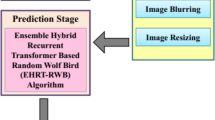Abstract
In recent days medical clinics need more analysis in heart disease because of most dangerous disease caused mostly worldwide affected by the people. By analyzing the characteristic features are high dimension due to complex structure of data analysis. Hence, the input features can be extracted with deep learning (DL) techniques to impart relevant recommendations and forecasts. DL techniques also play an essential character in early diagnosis and keeping an eye on heart disease. Numerous types of research have been conducted in this medical domain to predict heart disease at an early stage. To this end, we propose a novel Bi-directional Recurrent Network and Neuro-Fuzzy-based (BRN-NF) frequent pattern mining for heart disease prediction. Meanwhile, in the BRN-NF method, a Bi-directional Recurrent Neural Network is used for frequent pattern (i.e., feature) mining. Next, with the mined results, the Bi-directional Recurrent Network Neuro-Fuzzy Inference algorithm is employed for heart disease prediction. We endorse and calculate the disease deficiency rate based on feature selection and classification to analyses the data from the Cardiovascular Disease data set. Experiments and comparisons on Cardiovascular Disease data show that, compared to existing heart disease prediction considering highly accurate predictors and considering present/past factors results in improvements in prediction time, prediction accuracy, sensitivity and specificity to a significant extent. The accurate heart disease predictions acquired from the comparative explorations indicate the notable performance of our proposed method.







Similar content being viewed by others
References
Pan Y, Fu M, Cheng B, Tao X, Guo J. Enhanced deep learning assisted convolutional neural network for heart disease prediction on the internet of medical things platform. IEEE Access. 2020;8:189503–12.
Shankar V, Kumar V, Devagade U, Karanth V, Rohitaksha K. Heart disease prediction using CNN algorithm. SN Comput Sci. 2020;1:170.
Beulah C, Christalin Latha S, Jeeva C. Improving the accuracy of prediction of heart disease risk based onensemble classification techniques. Inform Med Unlocked. 2019;16:1–9.
Joffe C, Sheu R, Keeshan C, Burbano V. The role of novel transcatheter procedures in patients with congenital heart disease. J Cardiothorac Vasc Anesth. 2021;35:2180–93.
Li P, Haq U, Din U, Khan J, Khan A, Saboor A. Heart disease identification method using machine learning classification in E-Healthcare. IEEE Access. 2020;8:107562–82.
Beunza J, Puertas E, Vejero G, Villalba G, Condesa E, Kolev G. Comparison of machine learning algorithms for clinical event prediction (risk of coronary heart disease). J Biomed Inform. 2019;97: 103257.
Khan A, Algarni F. A healthcare monitoring system for the diagnosis of heart disease in the IoMT cloud environment using MSSO-ANFIS. IEEE Access. 2020;8:122259–69.
Ghosh P, Azam S, Jonkman M, Karim A, Javed Mehedi Shamrat A. Efficient prediction of cardiovascular disease using machine learning algorithms with relief and LASSO feature selection techniques. IEEE Access. 2021;9:19304–26.
Muhammad W, Hassan D, Hussain D, Nadeem M, Ameen B, Riad A. An efficient SMOTE-based deep learning model for heart attack prediction. Sci Program. 2021;2021:1–12.
Mohammed U, Rajib K. An ensemble method-based multilayer dynamic system to predict cardiovascular disease using a machine learning approach. Inform Med Unlocked. 2021;24:1–19. https://doi.org/10.1016/j.imu.2021.100584.
Almustafa K. Prediction of heart disease and classifiers’ sensitivity analysis. BMC Bioinform. 2020;21:278.
Zhang Z, Qiu Y, Yang X, Zhang M. Enhanced character-level deep convolutional neural networks for cardiovascular disease prediction. BMC Med Inform Decis Mak. 2021;30(3):123.
Kartik B, Shailendra Kumar S, Vivek S. An optimized XGBoost-based diagnostic system for effective prediction of heart disease. J King Saud Univ - Comput Inf Sci. 2022;34(7):4514–23.
Yazdani A, Varathan D, Chiam K, Malik W, Wan Ahmad W. A novel approach for heart disease prediction using strength scores with significant predictors. BMC Med Inform Decis Mak. 2021;21:194.
Gárate-Escamila K, El Hassani H, Andrès E. Classification models for heart disease prediction using feature selection and PCA. Inform Med Unlocked. 2020;19:1–11.
Tan L, Yu K, Bashir A. Toward real-time and efficient cardiovascular monitoring for COVID-19 patients by 5G-enabled wearable medical devices: a deep learning approach. Neural Comput Appl. 2021;4:1–14.
Ibomoiye M, Yanxia S, Wang Z. An improved ensemble learning approach for the prediction of heart disease risk. Inform Med Unlocked. 2020;20:1–5.
Lu H, Liu A, Fuh C, Lian Y, Guo L, Yang Y. Recurrent disease progression networks for modelling risk trajectory of heart failure. PLoS ONE. 2021. https://doi.org/10.1371/journal.pone.0245177.
Yahaya L, Oye N, Garba E. A comprehensive review on heart disease prediction using data mining and machine learning techniques. Am J Artif Intell. 2020;4:20–9.
https://www.kaggle.com/sulianova/cardiovascular-disease-dataset.
Funding
No funding received for this research.
Author information
Authors and Affiliations
Corresponding author
Ethics declarations
Conflict of Interest
No conflict of interest.
Additional information
Publisher's Note
Springer Nature remains neutral with regard to jurisdictional claims in published maps and institutional affiliations.
This article is part of the topical collection “Advances in Computational Approaches for Image Processing, Wireless Networks, Cloud Applications and Network Security” guest edited by P. Raviraj, Maode Ma and Roopashree H R.
Rights and permissions
Springer Nature or its licensor (e.g. a society or other partner) holds exclusive rights to this article under a publishing agreement with the author(s) or other rightsholder(s); author self-archiving of the accepted manuscript version of this article is solely governed by the terms of such publishing agreement and applicable law.
About this article
Cite this article
Meenal, M.R., Vennila, S.M. Bidirectional Recurrent Network and Neuro-fuzzy Frequent Pattern Mining for Heart Disease Prediction. SN COMPUT. SCI. 4, 379 (2023). https://doi.org/10.1007/s42979-023-01711-6
Received:
Accepted:
Published:
DOI: https://doi.org/10.1007/s42979-023-01711-6




